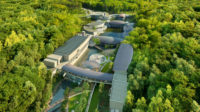Moshe Safdie was surprised. For the first time since he started working on the Crystal Bridges Museum of American Art in Bentonville, Arkansas, 11 years ago, one of the three large ponds he designed for the center of the property was full. Though not by choice.
For hours, torrential rain had pounded the site, a valley in which the museum surrounds (and sometimes spans) acres of Safdie-designed ponds. Except for the fact that the water was thick with mud, the effect, after the sun appeared, was picturesque. Safdie himself shot photos on his iPhone, not just of the scene outside the museum but also of the light reflecting off the pond onto the gallery ceilings. It was something he had waited more than a decade to see, he said, and it had produced some of the magic he had hoped for.
But by the next morning, the pond was being drained, and workers continued getting it ready for the museum’s November 9 members' preview (followed by a public opening two days later). That huge job involves lining the ponds with plastic, so that three weeks from now, the water will as crystal-clear as the museum’s name demands.
Putting a museum containing many of the acknowledged masterpieces of American art above ponds fed by an active spring smacks of hubris. But a complex flood control system, approved by three separate consultants and monitored by the Army Corps of Engineers, has been designed to protect the building and its contents. Crystal Bridges’ executive director, Don Bacigalupi, said in an interview that the confluence of running water and precious artworks worried him when he first took the job—but now, having studied the plans, he believes, the museum is prepared for what he called “the next Noah flood.”
The high-water act pretty much sums up the paradox of Crystal Bridges. Alice Walton, the Walmart heir who founded, and largely funded, the museum, chose to build it in the town where her father opened his first five-and-dime. (Sam Walton’s original store, now operated as a cozy Walmart history museum, is a few blocks away.) But Sam's daughter, who is famous for being unpretentious, let the project evolve into an architectural extravaganza, comparable to some of Safdie’s other recent projects, the curving Kauffman Center for the Performing Arts, in Kansas City, and the Marina Bay Sands resort complex in Singapore (with a park cantilevered off three 55-story towers), beautiful forms arranged for maximum impact. (The first cost more than $300 million; the second at least $3 billion—Crystal Bridges likely falls somewhere in between.) Except for Santiago Calatrava, who reportedly charged Denver International Airport $13 million for two years of conceptual work on an airport expansion that he recently walked away from, no other architect consistently delivers so much drama.
Here, Safdie covered the museum’s half dozen pavilions, totaling some 200,000 square feet, with swoopy, copper-covered roofs. The pavilions are, in several cases, actual bridges, supported by four-inch-thick steel cables set into to concrete anchorages. The cables form catenary curves as the buildings’ massive glued laminated timber beams push down on them, a tour-de-forces conceived by Safdie and executed with the help of Buro Happold, but also, with so many complicated buildings surrounding the trio of ponds, a kind of architectural three-ring circus.
Ambitious as it is, the museum is never overbearing. It contains some of the loveliest galleries since Safdie’s Peabody-Essex Museum opened in Salem, Massachusetts, in 2003. At Crystal Bridges, the two main exhibition spaces parallel the stream, in long, gently curved rooms that seem to hold back the surrounding hillsides. Their roofs, supported by the timber beams, curve gently downward toward the river, mimicking the shape of the valley and giving the curators a variety of wall and ceiling heights to work with. They have used the low walls for paintings by the likes of Frederic Church, Thomas Eakins, and Winslow Homer, and the high walls for monumental pieces by Louise Nevelson, Joan Mitchell, and others.
One of the themes that runs throughout the museum, curators said repeatedly during a press tour, is “strong women,” whether in the astonishing series of portraits an 18th century German-Jewish family in New York, Norman Rockwell’s 1943 Rosie the Riveter, or a 1985 Warhol portrait of Dolly Parton. The curving walls of the galleries give the curators a chance to represent the sweep of art history, and they do. (About one third of the museum’s 1,200 objects are on display.)
But until construction is complete, the stunning collection, and Safdie’s handsome buildings, are nearly overshadowed by the engineering feat below. As Bacigalupi and Safdie walked around the complex, workers were installing layers of plastic, bentonite, gravel, sand, and rock, which will keep the pondwater and groundwater from mingling. (Some 3 million gallons will be required to fill the ponds, and if nature doesn’t cooperate in time for the opening—the original Crystal Spring is good for 150 gallons an hour—some of it will have to come from city pipes.)
It’s ironic that Safdie’s first instinct—to mimic the natural contours of the valley—evolved into a plan in which swaths of that valley are now lined in plastic, and a creek has morphed into a colossal "water feature." Another strong woman, Mother Nature, might not love the Crystal Bridges Museum. But then again, Mother Nature may not be as creative as Moshe Safdie, or as wealthy as Alice Walton.






Post a comment to this article
Report Abusive Comment